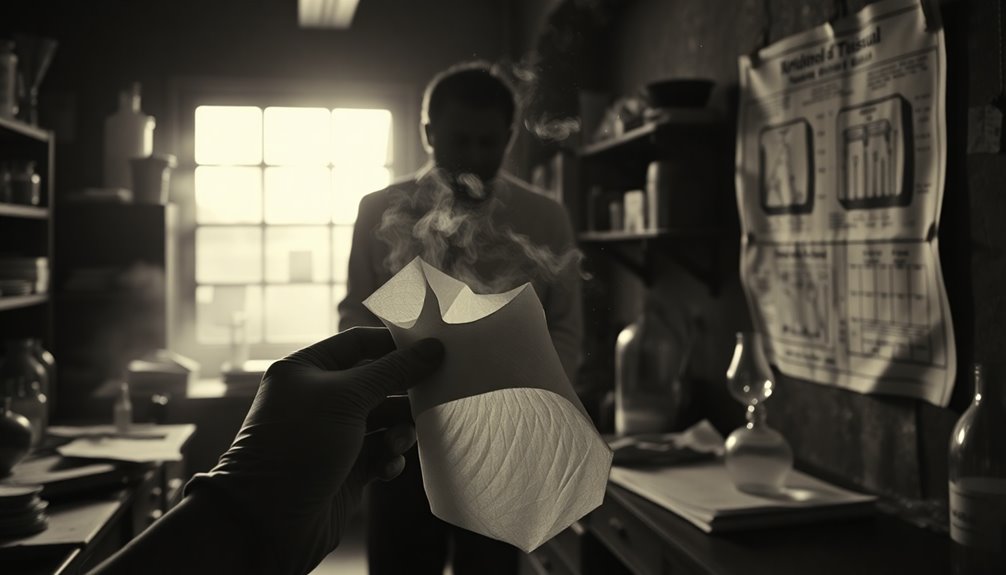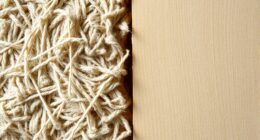You won't believe that most tissue paper is made from virgin wood pulp. This reliance on newly cut trees leads to deforestation and serious environmental problems. Although some brands claim to be eco-friendly, they often contain minimal recycled content, which can be misleading. The production process is resource-intensive, using a lot of water and chemicals, putting a strain on our ecosystems. Surprisingly, only about 2% of toilet paper is made from 100% recycled materials. If you're curious about the full impact and what truly constitutes 'eco-friendly,' stay tuned to uncover more surprising details.
Key Takeaways
- Most toilet paper is made from virgin wood pulp, with only 2% being 100% recycled paper.
- The production process heavily relies on freshly cut trees, contributing to deforestation and habitat loss.
- Eco-friendly labeled products often contain minimal recycled content, misleading consumers about their sustainability.
- Toilet paper production is resource-intensive, consuming large amounts of water and chemicals.
- Recycling tissue paper is often impractical due to its fragile nature, limiting disposal options.
Toilet Paper's Hidden Ingredients

When you reach for that roll of toilet paper, you might not realize what's really in it. Most toilet paper in the U.S. is made from freshly cut trees, primarily using virgin wood pulp. In fact, only about 2% of products contain 100% recycled paper. This reliance on virgin wood contributes to significant deforestation and environmental degradation. Many popular brands marketed as eco-friendly often mislead consumers; a study found they primarily use virgin hardwood instead of sustainable materials like bamboo fiber.
The demand for ultra-soft toilet paper drives companies to prioritize comfort over sustainability, leading to resource-intensive production processes. These processes consume large amounts of water and chemicals, further impacting the environment. You might think you're choosing a high-quality product, but what you're really doing is supporting an industry that often neglects eco-friendly practices.
If you want to make more sustainable choices, look for brands with higher recycled content. While options are limited, making informed decisions can help reduce the demand for virgin wood and promote more responsible production methods. Your choice can contribute to a healthier planet.
Toilet Paper Production Process

The journey from tree to toilet paper involves several steps that significantly impact the environment. Most toilet paper is made from virgin wood pulp sourced from trees, often from clear-cut forests, which leads to deforestation and habitat loss. You might not realize that only about 2% of toilet paper in the U.S. is produced from 100% recycled materials. This highlights our heavy reliance on freshly cut trees for production.
On average, you use around 140 rolls of toilet paper each year, creating a high demand that fuels unsustainable logging practices. The production process is resource-intensive, consuming vast amounts of water and chemicals. If you choose recycled paper products, you'll be glad to know that this method uses about half the water compared to virgin pulp production.
Your choices as a consumer matter. When you prioritize sustainable options, you can influence brands to adopt more environmentally friendly practices. By understanding the toilet paper production process and its environmental implications, you can make informed decisions that contribute to a healthier planet. So next time you buy toilet paper, consider the impact of your choice on the environment.
Eco-Friendly Disposal Methods

Considering the environmental impact of tissue paper, finding eco-friendly disposal methods is essential for reducing waste and promoting sustainability. Instead of simply tossing used tissue paper in the trash, think about composting it. If the tissue is uncoated, free from dyes, and chemicals, it can break down naturally and enrich your soil, making it a fantastic addition to your compost bin.
While recycling tissue paper isn't often feasible due to its fragile nature, you can still extend its life by using it creatively. Consider reusing it for art projects, where it can add unique texture and color without contributing to landfill waste. You might also use it as packing material when shipping items, which helps reduce the need for new materials.
Educating yourself about the environmental impact of tissue paper production and disposal can lead to more conscious choices in your daily life. By opting for recycled or alternative materials, you can further lessen your ecological footprint. Embracing these eco-friendly disposal methods will not only benefit the environment but also encourage others to think critically about their waste.
Environmental Impact Assessments

Regularly assessing the environmental impact of tissue paper production is crucial for understanding its effects on ecosystems and resources. The industry primarily relies on virgin wood pulp, which contributes significantly to deforestation and habitat loss, especially in sensitive areas like boreal forests. By conducting thorough environmental impact assessments, you can identify how much wood is harvested and the subsequent consequences on biodiversity.
The production process is resource-intensive, consuming vast amounts of water and chemicals, which often leads to pollution and ecosystem disruption. With the average U.S. citizen using around 140 rolls of toilet paper annually—most of which come from freshly cut trees—it's clear that the current practices are unsustainable. Shockingly, only 2% of toilet paper in the U.S. is made from 100% recycled materials, indicating a significant gap in adopting sustainable solutions.
Moreover, misleading marketing claims regarding eco-friendliness can confuse consumers, making it essential for you to rely on credible assessments when choosing tissue products. By prioritizing transparency and sustainability, we can collectively push for a healthier planet while still enjoying the conveniences of tissue paper.
Consumer Reports on Brands

Consumer awareness around tissue paper brands is rising as shoppers become more critical of sustainability claims. Many popular brands, like Bazoo, Naked Sprout, and Bumboo, might market themselves as eco-friendly, but studies show they contain minimal recycled content and primarily rely on virgin hardwood. This contradiction between their claims and actual content undermines consumer trust.
You might find yourself questioning the effectiveness of certifications like FSC, as scrutiny over their true sustainability continues to grow. This situation has fueled skepticism among consumers, especially with concerns about greenwashing—where brands exaggerate or misrepresent their environmental commitments.
As a shopper, you're likely looking for a better option, one that genuinely supports sustainability. Increased demand for transparency is crucial; many brands test their products for recycled content but still fall short of their sustainability goals.
Navigating the tissue paper market can be confusing, but understanding the facts helps you make informed choices. Keep an eye out for brands that prioritize genuine eco-friendly practices. Your choice can influence the industry, pushing brands towards more sustainable practices.
Industry's Reliance on Virgin Pulp

In the tissue paper industry, reliance on virgin wood pulp is a significant concern, as it drives deforestation and habitat loss. You might be surprised to learn that the majority of tissue products in the U.S. originate from freshly cut trees, with about 35% of North America's harvested trees going towards paper production. The industry's high consumer demand for softness pushes manufacturers to favor virgin pulp over recycled materials.
Only about 2% of tissue paper in the U.S. is made from 100% recycled content, which underscores just how deeply the industry is entrenched in its reliance on virgin resources. This preference not only exacerbates deforestation but also leads to substantial environmental impacts. The production of virgin pulp is resource-intensive, requiring significant amounts of water and generating chemical pollution that harms ecosystems.
As a consumer, understanding this reliance on virgin pulp can empower you to make more informed choices. By opting for products made from recycled materials, you can help reduce the demand for virgin pulp and contribute to a more sustainable future. Your choices matter in the fight against deforestation and environmental degradation.
Frequently Asked Questions
What Material Is Tissue Paper Made Of?
Tissue paper is primarily made from virgin wood pulp, which comes from freshly cut trees. This process requires a significant amount of water and chemicals, leading to environmental concerns. You'll notice that tissue paper is much thinner and more delicate than other types of paper, affecting its strength and usability. Most tissue papers lack recycled content, with only a small percentage incorporating post-consumer materials. So, it's essential to consider sustainability when using it.
How Many Trees Are Cut Down for Tissue Paper?
When you consider how many trees are cut down for tissue paper, it's staggering. In the U.S., about 35% of harvested trees go to paper products, including tissue. Each person uses around 140 rolls of toilet paper annually, which drives significant deforestation. Most tissue paper comes from freshly cut trees rather than recycled material, leading to habitat loss and biodiversity decline. It's crucial to think about sustainable alternatives and support recycled products.
What Is the Ingredient of Tissue Paper?
Tissue paper's main ingredient is wood pulp, sourced from trees. It often includes both hardwood and softwood fibers to enhance its softness and absorbency. You might also find brands that use recycled paper materials. Keep in mind, though, that the production process can be resource-intensive, involving high water usage and chemicals, which can impact the environment. So, when you choose tissue paper, consider options that prioritize sustainability and eco-friendliness.
Is Bamboo Toilet Paper Greenwashing?
Yes, bamboo toilet paper can be a form of greenwashing. Many brands market their products as eco-friendly, but tests reveal minimal bamboo content, often relying on virgin hardwood instead. This misrepresentation undermines consumer trust and highlights the need for transparency. While some brands, like Who Gives A Crap, offer genuine bamboo products, it's crucial for you to research and choose brands that truly uphold their sustainability claims.










